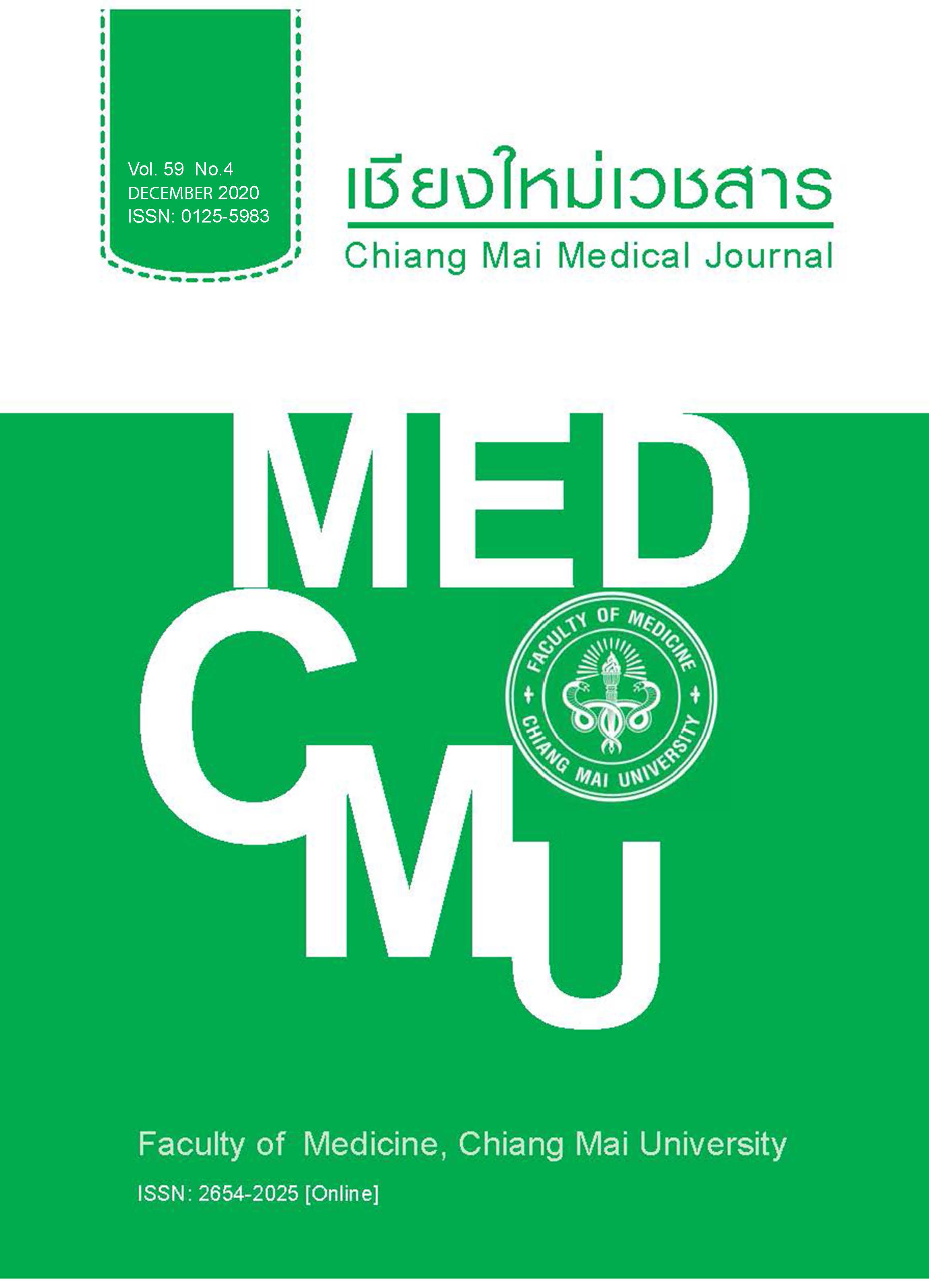การประเมินนำร่องระบบรายงานออนไลน์ผู้สัมผัสโรคพิษสุนัขบ้า (ร. 36) และเวชปฏิบัติในการให้ภูมิคุ้มกันโรคพิษสุนัขบ้าหลังสัมผัสโรค ของโรงพยาบาลที่ถูกเลือกในเขตภาคเหนือตอนบนของประเทศไทย ปีงบประมาณ พ.ศ. 2559
Main Article Content
บทคัดย่อ
วัตถุประสงค์ เพื่อประเมินระบบรายงานออนไลน์ผู้สัมผัสโรคพิษสุนัขบ้า (ร. 36) และเวชปฏิบัติในการให้ภูมิคุ้มกันป้องกันโรคพิษสุนัขบ้าหลังสัมผัสโรค
วิธีการ การศึกษานำร่อง แบบภาคตัดขวางในโรงพยาบาลเวียงแก่น เชียงของ และสองแคว ในช่วงกลางเดือนมกราคม พ.ศ. 2560 โดยใช้ข้อมูลของปีงบประมาณ พ.ศ. 2559 และสัมภาษณ์ผู้เกี่ยวข้อง ข้อมูลของการประเมินระบบรายงานนำเสนอในรูปแบบคุณลักษณะเชิงปริมาณและคุณภาพ สำหรับการประเมินและเวชปฏิบัติในการให้ภูมิคุ้มกันโรคพิษสุนัขบ้าหลังสัมผัสโรคนำเสนอในรูปของร้อยละและอธิบายข้อผิดพลาดของการดูแลรักษาที่ไม่ปฏิบัติตามแนวทางเวชปฏิบัติโรคพิษสุนัขบ้าของประเทศไทย พ.ศ. 2559 ส่วนปัจจัยที่สัมพันธ์กับการรักษาที่ไม่เป็นไปตามแนวทางเวชปฏิบัติได้ทำการถูกวิเคราะห์โดยวิธีการถดถอยโลจิสติกแบบพหุกลุ่ม
ผลการศึกษา พบว่ามีเพียง 2 โรงพยาบาลที่ใช้ระบบรายงานออนไลน์ผู้สัมผัสโรคพิษสุนัขบ้า (ร. 36) คือ โรงพยาบาลเวียงแก่นและเชียงของ ค่าความครอบคลุมของการรายงาน ความครบถ้วน ความถูกต้องของการรายงาน และค่ามัธยฐานของเวลาที่ใช้ในการรายงานนับจากการที่ผู้ป่วยได้รับวัคซีนป้องกันโรคพิษสุนัขบ้าเข็มแรก คือ ร้อยละ 73.08, 98.25, 70.18, และ 91 วัน สำหรับโรงพยาบาลเวียงแก่น และร้อยละ 37.12, 73.47, 36.73, และ 38 วัน สำหรับโรงพยาบาลเชียงของ ตามลำดับ การรักษาที่ไม่เป็นไปตามแนวทางเวชปฏิบัติ เช่น การให้วัคซีน หรืออิมมูโนโกลบูลินที่มากหรือน้อยเกินไป พบร้อยละ 34.62, 55.30 และ 44.44 ในโรงพยาบาลเวียงแก่น เชียงของ และสองแคว ตามลำดับ โดยปัจจัยเสี่ยงที่สัมพันธ์กับการรักษาที่ไม่เป็นไปตามแนวทางเวชปฏิบัติ คือ กลุ่มอายุ 13-18 ปี, การได้รับบาดเจ็บบริเวณศีรษะ และลำคอ บาดแผลฉีกขาด และการที่ไม่มีประวัติการได้รับวัคซีนป้องกันโรคพิษสุนัขบ้าที่เพียงพอในอดีต
สรุป เจ้าหน้าที่โรงพยาบาลเวียงแก่นควรปรับปรุงเรื่องระยะเวลาการรายงาน ส่วนเจ้าหน้าที่โรงพยาบาลเชียงของ ควรปรับปรุงเรื่องความครอบคลุม ความครบถ้วน และความถูกต้องของการรายงาน สำหรับเรื่องอัตราส่วนการไม่ปฏิบัติตามแนวทางเวชปฏิบัติที่มีค่าสูง แพทย์ และคณะผู้ดูแลรักษา ควรให้ความสนใจเป็นพิเศษในผู้ป่วยที่มีประวัติเสี่ยงดังกล่าว
Article Details

อนุญาตภายใต้เงื่อนไข Creative Commons Attribution-NonCommercial-NoDerivatives 4.0 International License.
เอกสารอ้างอิง
Fooks AR, Banyard AC, Horton DL, Johnson N, McElhinney LM, Jackson AC. Current status of rabies and prospects for elimination. Lancet. 2014;384(9951):1389-99.
World Health Organization, World Organization for Animal Health, Food and Agriculture Organization of the United Nations, Global Alliance for Rabies Control. Zero by 30: the Global Strategic Plan to end human deaths from dog-mediated rabies by 2030. Geneva: World Health Organization; 2018.
WHO Expert Consultation on Rabies: third report. Geneva: World Health Organization; 2018.
Hampson K, Coudeville L, Lembo T, Sambo M, Kieffer A, Attlan M et al. Estimating the global burden of endemic canine rabies. PLoS Negl Trop Dis. 2015;9: e0003709.
Knobel DL, Cleaveland S, Coleman PG, Fèvre EM, Meltzer MI, Miranda MEG et al. Re-evaluating the burden of rabies in Africa and Asia. Bull World Health Organ. 2005;83:360-8.
Hinojoy S, Poonkesorn S, Kongyu S, Chuknum T, Kumphon P, Choomkasien P. Guideline for surveillance, prevention and control of rabies in Thailand, 2018: based on epidemiological data. Weekly Epidemiological Surveillance Report. 2018;49:161-3.
Her Royal Highness Princess Chulabhorn Mahidol. The strategic plan of Animal free of rabies; Human are safe from the disease project 2017-2020 (Internet). 2017 (cited 2020 June 01). Available from: http://r36.ddc.moph.go.th/r36/document/view/19/135.
Centers for Disease Control and Prevention (CDC). Updated guidelines for evaluating public health surveillance systems: recommendations from the Guidelines Working Group. Morbidity and Mortality Weekly Review. Recommendation and Reports. 2001.
Department of Disease Control, Thai Ministry of Public Health. Clinical Practice Guideline for rabies and frequently asked questions. 5th ed. Bangkok: Aksorn Graphic and Design Publishing House; 2016.
World Health Organization. Rabies Vaccines: WHO Position Paper -April 2018. Weekly Epidemiological Record, No. 16; 2018, 93. 201-20.
Permanent Secretary of Thai Ministry of Public Health. Informing the change of Clinical Practice Guideline for rabies. The official letter of Thai Ministry of Public Health to all Provincial Public Health Medical Doctor on 2 May 2018.
Vora NM, Clippard JR, Stobierski MG, Signs K, Blanton JD. Animal bite and rabies postexposure prophylaxis reporting—United States, 2013. J Public Health Manag Pract. 2015; 21:e24-7.
Li AJ, Sreenivasan N, Siddiqi UR, Tahmina S, Penjor K, Sovann L, et al. Descriptive assessment of rabies post-exposure prophylaxis procurement, distribution, monitoring, and reporting in four Asian countries: Bangladesh, Bhutan, Cambodia, and Sri Lanka, 2017–2018. Vaccine. 2018.
Thiede H, Close NS, Koepsell J, Baer A, Duchin JS, Completeness of reporting of rabies postexposure prophylaxis in King County, Washington. J Public Health Manag Pract. 2008;14:448-453.
Bemis K, Frias M, Patel MT, Christiansen D. Using an Emergency Department Syndromic Surveillance System to Evaluate Reporting of Potential Rabies Exposures, Illinois, 2013–2015. Public Health Rep. 2017; 132:1.
Buss SN, Eidson M. State requirements for rabies-related animal control. J Public Health Manag Pract. 2012; 18:E17-23.
Sittichanbuncha Y, Chairat C, Sawanyawisuth K. Rabies postexposure vaccination in Thailand: is it performed according to international guidelines? Asian Biomed 2014;8:393-7.
Yurachai O, Hinjoy S, Wallace RM. An epidemiological study of suspected rabies exposures and adherence to rabies post-exposure prophylaxis in Eastern Thailand, 2015. PLoS Negl Trop Dis. 2020;14:e0007248.
Tran CH, Afriyie DO, Pham TN, et al. Rabies post-exposure prophylaxis initiation and adherence among patients in Vietnam, 2014-2016. Vaccine. 2019;37 Suppl 1:A54-63.
Thompson PG. The public health impact of dog attacks in a major Australian city. Med J Aust. 1997;167:129-32.
Titoria R, Gupta G. Adherence to Recommended Anti-Rabies Vaccine Schedule: A Rabies Clinic Based Study. Int J Preven Curat Comm Med. 2018;4:9-12.


